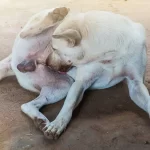Why Do Dogs Show Their Teeth
Dogs are known to be man’s best friend, but they also have some peculiar behaviors that can leave us scratching our heads. One of these behaviors is when dogs show their teeth. It can be alarming to see a dog baring its teeth, and many people wonder why they do it. In this article, we will explore the reasons behind this behavior and what it means in different situations.
The Anatomy of a Dog’s Teeth
Before we delve into why dogs show their teeth, it’s essential to understand the anatomy of a dog’s teeth. Dogs have four types of teeth: incisors, canines, premolars, and molars. Their incisors are used for biting and cutting, while the canines are used for grasping and tearing flesh. The premolars and molars are used for grinding food.
Dogs also have powerful jaws and muscles that allow them to exert immense pressure when biting down. They use their teeth not only for eating but also for defense and communication.
Reasons Why Dogs Show Their Teeth
1. Aggression
One of the primary reasons why dogs show their teeth is aggression. When a dog feels threatened or wants to protect its territory or resources, it may bare its teeth as a warning sign to back off. The display of teeth is often accompanied by growling, snarling, or barking.
It’s crucial to note that not all dogs display aggression in the same way. Some may growl without showing their teeth, while others may bark without any other signs of aggression. However, if you see a dog displaying its teeth along with other aggressive body language cues, such as raised hackles or a stiff posture, it’s best to give them space and avoid provoking them.
2. Fear
Fear is another reason why dogs show their teeth. When a dog feels scared or anxious, it may resort to displaying its teeth as a defense mechanism. This behavior is often seen in dogs that have experienced trauma or abuse in the past.
If you encounter a fearful dog, it’s essential to approach them slowly and calmly. Avoid making direct eye contact or sudden movements that may startle them. Give them plenty of space and time to calm down before attempting to interact with them.
3. Playfulness
Believe it or not, dogs may also show their teeth when they’re playing. This behavior is known as a “playful grin” and is often accompanied by wagging tails and excited body language.
Dogs use their teeth during play to grab toys, chase each other, or even wrestle. However, it’s crucial to monitor play sessions between dogs carefully. Sometimes what starts as playful behavior can quickly turn aggressive if one dog becomes overly rough or aggressive.
4. Submission
In some cases, dogs may show their teeth as a sign of submission. This behavior is often seen in puppies or younger dogs who are trying to communicate their submissiveness to older or more dominant dogs.
When displaying submissive behavior, dogs will often lower their heads, flatten their ears against their head, tuck in their tails, and show their bellies or throats. Displaying their teeth is another way for them to communicate that they pose no threat and are submitting to a more dominant dog’s authority.
5. Medical Issues
Finally, there may be medical reasons why a dog shows its teeth. Dental problems such as tooth decay, gum disease, or abscesses can cause pain and discomfort that may make a dog more irritable and prone to showing its teeth.
It’s crucial to take your dog for regular dental checkups and address any issues promptly to avoid long-term health complications.
Conclusion
In conclusion, dogs show their teeth for various reasons, including aggression, fear, playfulness, submission, and medical issues. Understanding why your dog is baring its teeth can help you respond appropriately and avoid potentially dangerous situations.
Remember that every dog is unique and may display different behaviors in different situations. If you’re unsure about what your dog’s behavior means, it’s best to seek the advice of a professional dog trainer or veterinarian.
So the next time you see a dog showing its teeth, take a moment to assess the situation and respond appropriately. And who knows, maybe one day, you’ll even be able to decode your furry friend’s toothy grin!



